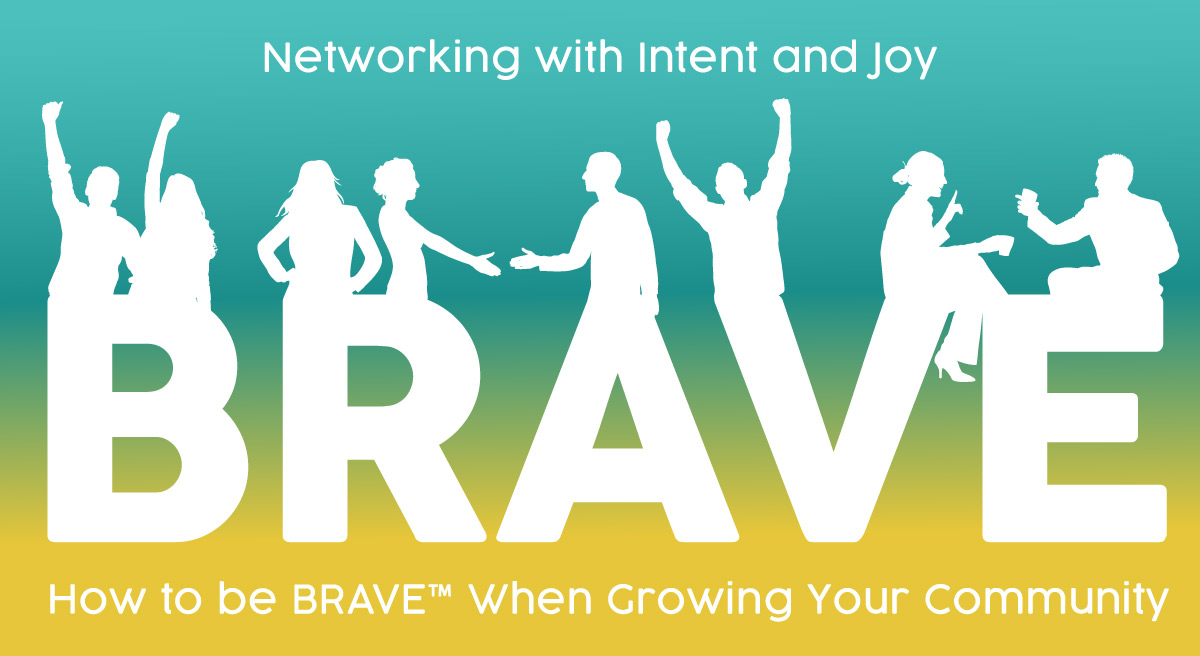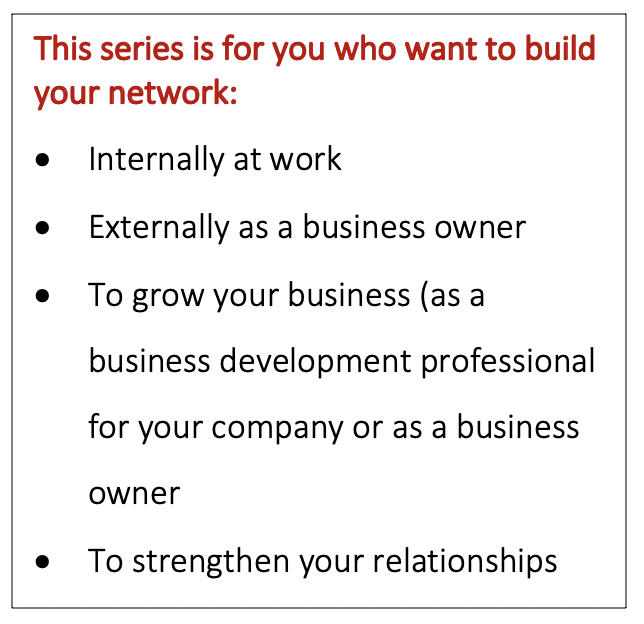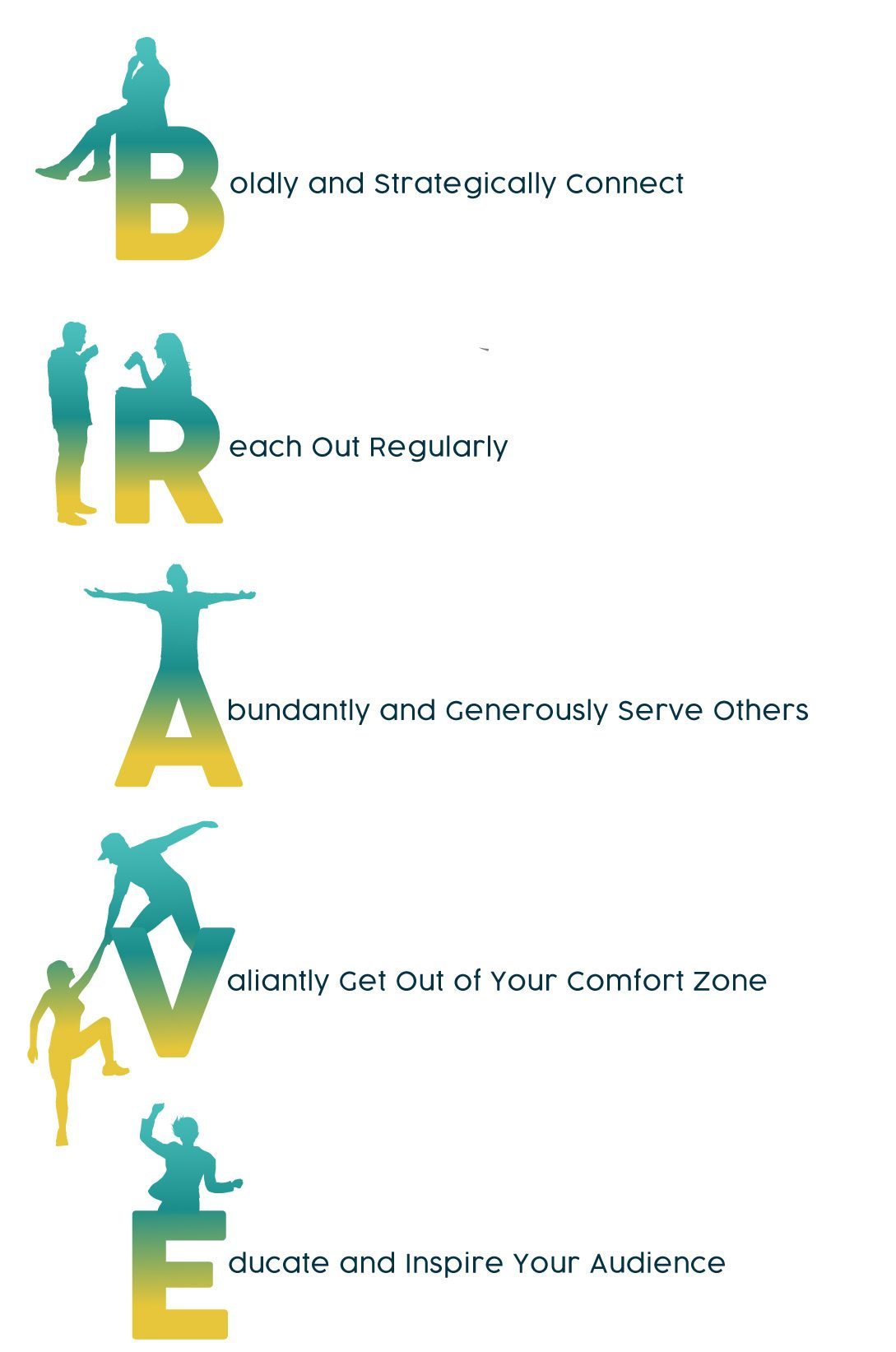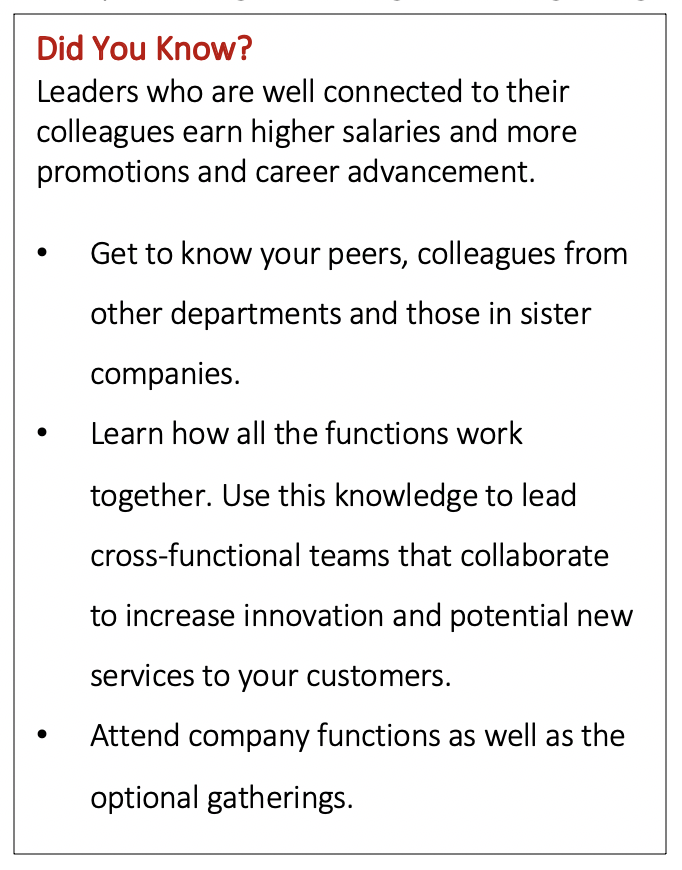
[A Five-Part Series on Building Relationships to Build Business and Community]
My client Muneera was ready for promotion yet had a challenge. “I have all the skills needed to get this promotion, as does my colleague, who is also being considered for the job. The bad news is…I think she will get the job. I always see her meeting up with people, having coffee, going to happy hours, chatting it up at company events — everyone seems to know her. How do I compete with that?”
 Another client, John, was ready to launch his own business but was hesitant and unclear. “I know my craft and I’m good at what I do – that’s the truth. The problem is I have no idea where to find clients. I don’t even know where to start.”
Another client, John, was ready to launch his own business but was hesitant and unclear. “I know my craft and I’m good at what I do – that’s the truth. The problem is I have no idea where to find clients. I don’t even know where to start.”
These scenarios may look different; however, the tasks ahead are the same. These professionals need to sharpen what I call their tribeworking skills. The word traditionally used for building and sustaining new relationships for furthering business and community is “networking.” However, if you think about it, what you are really trying to do is build groups of like-minded people with similar interests, values and goals who can help each other.
When this search has gone well, many clients tell me, “I found my tribe.” They are referring to a group of compatible people who are kind, inclusive, helpful and make them feel like they belong.

Rather than networking — tribeworking is about building relationships so you can build successes and help others along the way. I will use the term tribeworking as much as possible throughout this article to reinforce the positive nature of connecting with others and creating lasting groups you can turn to.
When I’m not using tribeworking, I will also use the term “business socializing events” so we can redefine a term and activity that makes many people resist.
In our more virtual world, I believe we have more ways to build a tribe, not fewer. I created this series as a guide for how I built my tribes in the last 10 years to grow my company, Strategy Meets Performance. I struggled as John did when a colleague presented me with the idea of starting my own business. It wasn’t until I started experimenting and taking a series of small actions that I learned that my perfect clients are actually waiting for me. All of our clients/colleagues are waiting for us to connect. After launching his business, John successfully followed a plan for meeting others. Muneera began connecting socially with her colleagues and also found success, not just in her career path, but also in helping others and creating innovative ideas with these colleagues.
If you remember one thing from this article series, remember that success routes can be learned. Just because you don’t know how to do something now does not mean that you can’t learn.
This can be done in steps. You will learn one step at a time in this five-part series by being BRAVE™.
At the end of each section, take the time to complete the reflections, as they will inform you and inspire you to try new behaviors. Let’s begin.
“Where to start?”
It is one of the questions I get asked the most by new entrepreneurs and business owners.
- “How do I make new connections?
- “Where do I go?”
- How many of those “networking” events do I have to go to? They kind of freak me out.”
- How do I find the people I’m meant to serve?”
There are likely some ways of connecting that seem natural and comfortable for you and some ways that seem extremely challenging and uncomfortable. The tough experiences help you learn more about yourself and ways you can connect and serve others that resonate with your personality and natural energies.

Learning how to reach out to your communities is an art. You can, as I eventually did, learn to go about connecting with others with intent and joy. Once you get the hang of it, it can also become one of the best parts of operating your business.
After reviewing how I went about it, I realized a couple of things. First, there are patterns for success, regardless of your industry.
Second, reaching out to others can require you to be BRAVE™ as it did for me. I created BRAVE™ to share the insights I attained over the years with my clients and community. There is so much more, and that’s why I believe Tribeworking Not Networking: Five Steps to a Booming Business, Career and Success is a lifelong journey. We, in fact, need to learn how to do some of these things in creative ways such as using video, phone or socially distanced walks.
In the words of my mentor, Dr. Jackie Martin,
“We’re here on this planet to do two things: to learn and to teach.”
With that, keep growing, learning and teaching.
PART 1 of 5
There are three things to consider as you discover how to crack the code of meeting the people who you can serve and support. First, figure out who your ideal clients are. Second, learn where you’d like to serve and offer your services to grow your and others’ businesses and to give back. Last, see where you can build a community.
Your Ideal Clients are Looking for You

Believe it or not, the people you are meant to serve are looking for you. According to the authors of Attracting Perfect Customers,[1] when you slow down and stay centered in your message, you shine bright like a lighthouse, guiding your perfect customers to you. “Instead of looking for customers, we should focus on how they can find you faster.” Part of this comes from getting clear on which clients fit perfectly with the products, services and philosophy that your company offers.
Consider the general characteristics your clients may have from being in a certain industry, being entrepreneurs, being involved with their families, in the community, etc. You can also consider more specific types of clients regarding age, background, lifestyle, etc. For each perfect client, think about what drives and interests the person. What challenges does the person face in his/her business? What strengths do they want to build on? How can you help with these challenges?
Next, think about where these perfect clients spend their time. Also, which types of service providers also serve this client? A big part of meeting your customers is building high quality relationships with those who serve them, so referrals can follow effortlessly.
Where Can you Serve?
Once you begin tribeworking, you will learn that you can be busy every day with an event, even in our new online world. The question is how you maximize the chances of meeting those you can serve best. Below are some ideas of where you can get involved. The best way to go about this is to find organizations that inspire you and are filled with like-minded people who share your values. All of these ideas can be applied to online events as well as connecting with others via Zoom.
- Go to fundraisers for nonprofits your friends and colleagues support – if the cause inspires you. These are natural settings for meeting new people in a more relaxed setting.
- Volunteer for a cause you believe in.
- Get on a nonprofit or industry organization’s board of directors.
- Join a group that meets regularly for the purpose of developing business relationships and ultimately, referrals. Go a few times to observe how people show up. Learn what they value, how inclusive they are and how inspired you feel as you exit. Do you feel comfortable meeting members outside of the group? Do they have appropriate professional behavior? Do they have a growth mindset? Determine what other values are important to you and if this group generally shares them.
 Several years ago, I became involved in the local chapter of Room to Read, a global nonprofit that helps builds schools and libraries in developing countries, particularly where schooling for girls ends after grade school. I was inspired to do this work because educating girls helps them go to college, versus getting forced to work on the family farm and getting married early, thus repeating the cycle of poverty. Helping send these girls to school was so important to me that my team of volunteers and I hosted events and raised awareness and funds. As our team collaborated and had events at local restaurants, I built inviting my community into my outreach plan. One colleague saw how passionately I spoke about the organization and asked if I give talks to companies. As a result, he referred me to speak to his CEOs, and I ended up helping one of them improve his company’s leadership and culture.
Several years ago, I became involved in the local chapter of Room to Read, a global nonprofit that helps builds schools and libraries in developing countries, particularly where schooling for girls ends after grade school. I was inspired to do this work because educating girls helps them go to college, versus getting forced to work on the family farm and getting married early, thus repeating the cycle of poverty. Helping send these girls to school was so important to me that my team of volunteers and I hosted events and raised awareness and funds. As our team collaborated and had events at local restaurants, I built inviting my community into my outreach plan. One colleague saw how passionately I spoke about the organization and asked if I give talks to companies. As a result, he referred me to speak to his CEOs, and I ended up helping one of them improve his company’s leadership and culture.
Through doing work I was passionate about, I attracted a like-minded person who thought I’d be a good match for his group.
Where Can You Build Community?
You don’t have to rely on what’s already out there, you can get creative and create your own groups. I have created my own groups over the years, whether it was a group of four ladies supporting each other’s goals, a mixed group of service providers or a group of talented female professionals at the top of their games. This is your chance to get creative and bring energy to people who are hungry to meet and grow with others.
Your Next Steps
Consider the following exercises in the next week as you consider how you can meet the right people who you can serve.
- Describe your ideal client. Where does she/he spend time? What groups are they interested in? What is important to them? As you come up with the different qualities, ask yourself if you have those qualities or if you can work on developing those qualities because like attracts like and you want to be who you want to attract.
- Consider what groups you can join. It could be an industry group, a “networking group” or a group you can serve in your area of expertise. Think about what nonprofits in town inspire you. Ask your colleagues what groups they are in.
- Identify and build relationships with professionals who share your target market. Make sure that colleagues who serve your type of client understand your services as you would understand what they do. When the time and situation is appropriate, refer clients to these trusted and talented professionals generously.
- Create your own community. Think about what group of people you’d love to bring together so you can create a community. A fun new idea can be to schedule a Zoom chat with two of your contacts who have not yet met but you believe can help one another. The three-person chat can have a unique and fun feeling to it, compared to a two-person chat, especially if you and your colleague are up to speed with what the other is doing. Invite your colleagues and contacts to do the same.
[1] Hall, St. & Brogniez, J. Attracting Perfect Customers.




